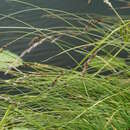Associations
provided by BioImages, the virtual fieldguide, UK
Foodplant / saprobe
superficial pseudothecium of Acanthophiobolus helicosporus is saprobic on dead leaf of Carex paniculata
Remarks: season: 5-10
Foodplant / saprobe
immersed, clypeate perithecium of Anthostomella caricis is saprobic on dead leaf of Carex paniculata
Remarks: season: 3-10
Foodplant / saprobe
subclypeate perithecium of Anthostomella limitata is saprobic on dead leaf of Carex paniculata
Remarks: season: 4-12
Foodplant / saprobe
immersed, clypeate perithecium of Anthostomella tomicoides is saprobic on dead leaf of Carex paniculata
Other: major host/prey
In Great Britain and/or Ireland:
Foodplant / saprobe
sporodochium of Arthrinium dematiaceous anamorph of Arthrinium sporophleum is saprobic on newly dead leaf of Carex paniculata
Remarks: season: 3-4
Foodplant / saprobe
immersed perithecium of Ceriophora palustris is saprobic on dead leaf of Carex paniculata
Remarks: season: 3-8
Foodplant / feeds on
adult of Donacia impressa feeds on pollen of Carex paniculata
Remarks: season: 5-6
Other: major host/prey
Foodplant / saprobe
pycnidium of Ascochyta coelomycetous anamorph of Eriospora leucostoma is saprobic on dead leaf of Carex paniculata
Remarks: season: 2-4
Foodplant / open feeder
larva of Eutomostethus punctatus grazes on leaf of Carex paniculata
Other: sole host/prey
Foodplant / saprobe
short-stalked apothecium of Lachnum caricis is saprobic on dead leaf of Carex paniculata
Remarks: season: 5-8
Foodplant / saprobe
immersed, opening by slit apothecium of Lophodermium caricinum is saprobic on dead leaf (mostly near base) of Carex paniculata
Remarks: season: 5-6
Foodplant / saprobe
effuse colony of Tetraploa dematiaceous anamorph of Massarina tetraploa is saprobic on Carex paniculata
Remarks: season: 1-12
Foodplant / saprobe
superficial, sessile, clypeate apothecium of Micropeziza cornea is saprobic on dead stem of Carex paniculata
Remarks: season: 3-7
Foodplant / saprobe
sessile apothecium of Mollisia humidicola is saprobic on dead leaf of Carex paniculata
Remarks: season: 1-9
Foodplant / parasite
stromatic, shortly and stoutly stalked apothecium of Myriosclerotinia duriaeana parasitises stem of Carex paniculata
Remarks: season: 5-6
Foodplant / parasite
scattered sporodochium of Myriosclerotinia sulcatula parasitises stem (upper parts) of Carex paniculata
Remarks: season: late summer
Foodplant / saprobe
stalked, occasionally sessile sporodochium of Myrothecium dematiaceous anamorph of Myrothecium cinctum is saprobic on dead leaf of Carex paniculata
Remarks: season: 3-5
Foodplant / saprobe
scattered, immersed, amphigenous pycnidium of Neottiospora coelomycetous anamorph of Neottiospora caricina is saprobic on dead leaf of Carex paniculata
Foodplant / saprobe
superficial perithecium of Niesslia exosporioides is saprobic on dry, dead leaf of Carex paniculata
Remarks: season: 4-8
Foodplant / saprobe
colony of Periconia dematiaceous anamorph of Periconia atra is saprobic on dead leaf of Carex paniculata
Remarks: season: 4-9
Foodplant / saprobe
colony of Periconia dematiaceous anamorph of Periconia curta is saprobic on dead stem of Carex paniculata
Remarks: season: 1-12
Foodplant / saprobe
colony of Periconia dematiaceous anamorph of Periconia digitata is saprobic on dead stem of Carex paniculata
Remarks: season: mainly winter
Foodplant / saprobe
effuse colony of Periconia dematiaceous anamorph of Periconia hispidula is saprobic on dry, dead leaf of Carex paniculata
Remarks: season: 1-12
Foodplant / saprobe
fruitbody of Phlebiella aurora is saprobic on dead, decayed stem of Carex paniculata
Other: sole host/prey
Foodplant / parasite
telium of Puccinia caricina var. ribis-nigri-paniculatae parasitises live Carex paniculata
Foodplant / parasite
telium of Puccinia opizii parasitises live Carex paniculata
Foodplant / spot causer
very numerous, crowded, black pycnidium of Septoria coelomycetous anamorph of Septoria caricis causes spots on dead leaf tip of Carex paniculata
Remarks: season: 7-8
Foodplant / feeds on
Thryogenes fiorii feeds on stem of Carex paniculata
Foodplant / saprobe
sporodochium of Volutella anamorph of Volutella arundinis is saprobic on dead leaf of Carex paniculata
Foodplant / saprobe
embedded pseudothecium of Wettsteinina niesslii is saprobic on dead, wet stem of Carex paniculata
Remarks: season: 2
Carex paniculata: Brief Summary
provided by wikipedia EN
Carex paniculata, the greater tussock-sedge, is a species of flowering plant in the sedge family, Cyperaceae. It grows 1.5 metres (4 ft 11 in) high and can be found in most of Europe (including Britain), Northwest Asia and North America.
- license
- cc-by-sa-3.0
- copyright
- Wikipedia authors and editors

